
The coupon rate formula is a fundamental concept in finance that helps investors understand the interest rate paid on a bond.
The coupon rate is the annual rate of interest paid by the bond issuer to the bondholder.
A bond's coupon rate is typically expressed as a percentage of its face value, which is the amount borrowed by the issuer.
For example, if a bond has a face value of $1,000 and a coupon rate of 5%, the bondholder will receive $50 in interest each year.
What Is a Coupon Rate?
The coupon rate is the interest rate a bond issuer promises to pay its investors on a regular basis, usually semiannually or annually. This rate is a crucial aspect of a bond's characteristics.
The coupon rate is often expressed as a percentage of the bond's face value, which is the amount the issuer promises to repay to the investor at maturity. For example, if a bond has a face value of $1,000 and a coupon rate of 5%, the issuer will pay the investor $50 in interest every year.
A higher coupon rate generally indicates a higher credit risk for the issuer, as they are offering a more attractive interest rate to investors to compensate for the increased risk. This is because bonds with higher coupon rates are often considered to be riskier investments.
The coupon rate is a key factor in determining the bond's market price, which is the price at which investors are willing to buy the bond from the issuer. If the market price of the bond is lower than its face value, it may be considered undervalued by investors.
In some cases, the coupon rate may be lower than the prevailing market interest rate, making the bond less attractive to investors. This can lead to a decrease in the bond's market price, as investors seek out bonds with higher yields.
Understanding Coupon Rate
The coupon rate is a vital component of the bond market, and understanding it is crucial for investors.
The coupon rate is the annual interest payment made by the bond issuer to the bondholder, typically expressed as a percentage of the bond's face value. For example, a $1,000 bond with a coupon of 7% pays $70 a year.
This interest payment is usually made semiannually, meaning the investor will receive $35 twice a year. The number of coupons provided with each bond allows investors to determine if they consistently get payment for their bonds.
The coupon rate is fixed until maturity, so bonds with higher coupon rates can provide some safety against rising market interest rates. However, the current yield can diverge from the bond's coupon or nominal yield due to market fluctuations.
The coupon rate is calculated by dividing the annual payments by the face value of the bond. For instance, if an investor purchases a $1,000 bond with a 5% coupon rate, the annual payment would be $50.
Coupon Rate Formula and Calculator
The coupon rate formula is a simple yet powerful tool for calculating the coupon rate of a bond. It's calculated by dividing the annual coupon payment by the face value of the bond, and then multiplying by 100.
To use the coupon rate formula, you can use a calculator or a spreadsheet like Excel. The formula is: Annual Coupon (or Interest) Payment x 100 / Face Value of Bond.
For example, if the annual coupon payment is $50 and the face value of the bond is $1,000, the coupon rate would be 5%. This means that the bondholder will receive $50 in interest payments each year.
The coupon rate formula helps investors compare the coupon rate of different fixed-income securities and choose the best one for their needs. It also helps assess the cycle of interest rates and the expected market value of a bond.
Here's a simple table to illustrate how to use the coupon rate formula:
Note that the coupon rate remains the same in all three examples, but the face value of the bond increases. This is because the coupon rate is calculated by dividing the annual coupon payment by the face value of the bond.
The coupon rate is an important factor in determining the bond's market value. If the bond's interest rate is below the market interest rate, the bond is said to be traded at a discount. Conversely, if the bond's interest rate is higher than the market interest rate, the bond is said to be traded at a premium.
Coupon Rate Impact and Payments
Coupon payments are made to bondholders at regular intervals, typically every six months in the US and annually in Singapore, and are determined by the bond's face value and coupon rate.
In the US, for example, a $1,000 bond with a 5% coupon rate would result in $25 in coupon payments every six months. The frequency of coupon payments can vary, but the amount is always calculated using the formula: Coupon payment = face value of the bond × coupon rate.
A bond's coupon rate is fixed until maturity, providing some safety against rising market interest rates. However, some bonds have variable rates, where coupon payments can change based on market conditions.
Market Interest Rate Impact
The market interest rate has a significant impact on bond coupons. The bond issuer decides on the coupon rate based on the market interest rates, which change over time. This causes the value of the bond to increase or decrease.
Bonds with higher coupon rates can provide some safety against rising market interest rates. This is because the fixed coupon rate is more attractive compared to the increasing market rates.
The value of a bond is directly affected by market interest rates. If interest rates rise, the value of the bond decreases, making it less attractive to investors.
Bonds with lower coupon rates are more susceptible to the impact of rising market interest rates. This is because their fixed coupon rate is lower than the increasing market rates.
Investors should consider the market interest rate when deciding on a bond investment. A bond with a higher coupon rate can provide a safer investment option in a rising interest rate environment.
Who Pays?
The bond issuer is responsible for paying the bond coupon to the bondholders. This payment includes the face value of the debt, plus interest.
The bond issuer must pay the coupon to bondholders as agreed upon in the bond contract. This ensures that investors receive their expected return on investment.
The face value of the debt, plus interest, is paid to bondholders at regular intervals, typically on a semi-annual or annual basis. This is a key aspect of coupon payments.
Here's a breakdown of the payment components:
By paying the coupon, the bond issuer fulfills its obligation to bondholders and maintains a positive relationship with investors.
Types of Payments
Coupon payments can be made in various ways, depending on the type of bond. A fixed-rate coupon is the most common type, where the interest rate remains the same for the bond's duration.
Some bonds have a floating-rate coupon, where the interest rate changes periodically based on a reference rate.
A step-up coupon has an escalating interest rate, increasing at predetermined periods.
Payment-in-kind (PIK) coupons allow the issuer to pay interest in the form of extra bonds or other assets instead of cash.
Bonds can be classified into different types of coupon payments, including fixed-rate, floating-rate, step-up, and payment-in-kind.
Frequently Asked Questions
How to calculate coupon amount?
To calculate the coupon amount, divide the annual coupon rate by the number of payments per year and multiply the result by the bond's face value. This simple calculation will give you the coupon payment per period.
How to calculate effective coupon rate?
To calculate the effective coupon rate, divide the annualized coupon payments by the par value of the bond. This simple calculation helps investors understand the true cost of borrowing for bond issuers.
How do I calculate coupon rate in Excel?
To calculate coupon rate in Excel, enter the par value of your bond in cell B1 and the formula "=A3/B1" in cell B2. This formula yields the annual coupon rate in decimal form, helping you understand the bond's interest rate.
How to calculate coupon rate with YTM?
Unfortunately, the YTM formula does not directly calculate the coupon rate. To find the coupon rate, you'll need to rearrange the YTM formula and use additional information about the bond's face value, market price, and compounding periods.
What is the formula for coupon bond price?
The formula for coupon bond price is Price = (Coupon × (1 + r)^(-n)) + Par Value × (1 + r)^(-n), broken down into the present value of coupons and the discounted par value. This formula calculates the total value of a bond based on its coupon rate, yield, and time to maturity.
Sources
- https://www.educba.com/coupon-rate-formula/
- https://www.mas.gov.sg/bonds-and-bills/singapore-government-t-bills-information-for-individuals
- https://www.investopedia.com/terms/c/coupon.asp
- https://corporatefinanceinstitute.com/resources/fixed-income/coupon-bond/
- https://www.poems.com.sg/glossary/bonds/coupon-payments/
Featured Images: pexels.com

